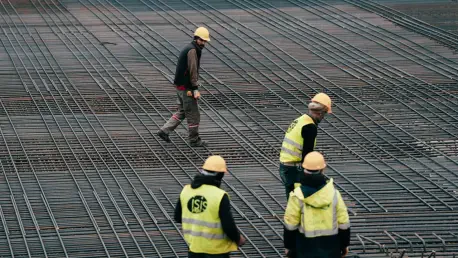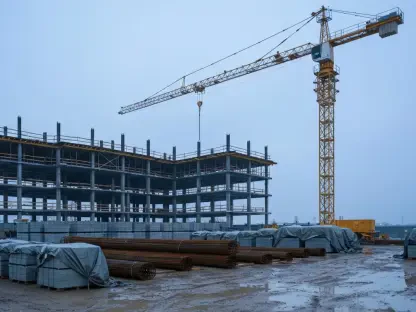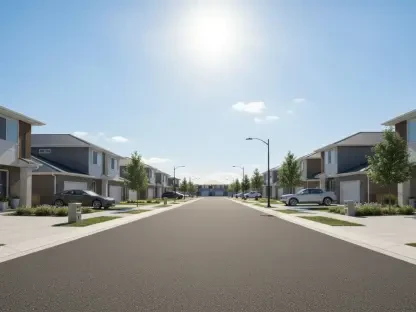The landscape of the single-family building market in 2025 reveals a scenario rich with promise yet shadowed by economic challenges. Notably, the sector experienced a 6.7% increase in building permits in the prior year, culminating in 981,834 units, a testament to the anticipated growth in demand for residential spaces. However, builders express concerns regarding the looming impact of tariffs on imported materials, a factor that threatens to significantly inflate construction costs. The National Association of Home Builders (NAHB) pointed out that a substantial 7.3% of materials utilized in residential construction are sourced from abroad, with new tariffs potentially escalating the cost of a new home by $9,200. These realities underscore the delicate balance between projected growth and looming economic hurdles as the market navigates through the complexities of 2025.
Economic Constraints and Market Dynamics
Tariff Challenges in the Construction Sector
The imposition of tariffs on building materials continues to pose a formidable challenge to the construction industry, where a holistic view of market dynamics reveals an intricate interplay between cost and demand. Builders find themselves at the crossroads of anticipation and apprehension, as higher tariffs inevitably translate into increased costs for consumers and potential profit margin squeeze for builders. According to a survey by the NAHB/Wells Fargo Housing Market Index, these tariffs heighten immediate concerns, shading the otherwise optimistic projections with a veneer of uncertainty. Market stakeholders recognize that understanding the complexities of global supply chains is critical, as tariffs influence not only costs but also the strategic sourcing decisions builders must make.
Lucy, an experienced editor-in-chief, underscores the pressing reality that while the sector is poised for growth, the influence of macroeconomic factors such as import duties cannot be ignored. His insights highlight how these external pressures necessitate adaptive strategies focused on balancing quality in construction with economic viability. Builders are urged to integrate foresight into their planning processes, leveraging regional advantages and local supply networks to mitigate tariff impacts. Moreover, Lucy emphasizes the importance of data analysis in understanding regional demand, suggesting that areas with robust local economies may better weather these challenges due to lower reliance on imported materials and stronger consumer bases.
Regional Resilience Amid Market Shifts
Despite these economic challenges, some metropolitan areas show remarkable resilience, navigating through market shifts with relative strength. These regions, driven by unique local economic dynamics and burgeoning housing demand, become focal points of growth and opportunity even as broader industry uncertainties persist. Analysts note that while tariffs pose financial burdens, they also spotlight the importance of regional economic strategies that can counterbalance global fluctuations. Metropolitan areas capitalizing on strong local economies may not only survive but thrive, driven by factors such as job growth and demographic shifts that perpetuate housing demand.
The narrative of regional resilience is further enriched by considering how local policy and governance address construction challenges. Areas leveraging supportive housing policies can buffer the impact of tariffs, offering incentives or support that keep projects attractive and feasible. Additionally, localized efforts to streamline building processes and reduce bureaucratic hurdles may play a critical role in maintaining momentum amid broader economic clouds. Through strategic adaptations and an acute focus on the role of regionalism in economic planning, these areas illustrate potential pathways for the broader market to emulate, fostering optimism amidst prevailing challenges.
Future Strategies and Adaptation
Strategic Adaptation and Foresight
As the industry continues to chart its future, strategic adaptation becomes paramount, with builders and stakeholders reassessing their approaches to ensure resilience. Central to these strategies is an understanding of the broader economic interplay caused by tariffs, emphasizing the need for agile response mechanisms and flexible planning. In practice, this might involve diversifying supply sources, investing in technology to improve efficiency, and exploring innovative materials as alternatives to traditional yet tariff-prone supplies. Lucy’s commentary highlights the critical role that ongoing data monitoring and analysis play in equipping builders with actionable insights to effectively forecast trends and prepare for shifts.
Moreover, there is an increasing emphasis on sustainability and green building practices as viable avenues to offset rising costs and appeal to environmentally conscious consumers. By incorporating energy-efficient designs and sustainable materials, builders can reduce dependencies on imported goods and introduce long-term savings that counter initial cost increases. Educating clients and stakeholders on the benefits of such practices can redefine market expectations, fostering support for a more sustainable construction paradigm. This strategic shift addresses immediate economic pressures and aligns with broader industry movements towards eco-friendly and sustainable development.
Looking Beyond 2025
The construction industry faces significant hurdles due to tariffs on building materials, creating a complex relationship between cost and demand. Builders confront a mix of anticipation and concern as tariffs boost costs for consumers and potentially shrink profits for builders. A NAHB/Wells Fargo Housing Market Index survey reflects this tension, adding uncertainty to otherwise positive forecasts. Understanding the complexities of global supply chains is critical since tariffs affect costs and strategic sourcing decisions.
Lucy, a seasoned editor-in-chief, stresses the importance of not overlooking macroeconomic influences like import duties in a growing sector. His insights highlight the need for adaptive strategies that balance construction quality with economic practicality. Builders are encouraged to integrate foresight into planning, utilizing regional advantages and local supply chains to offset tariffs. Lucy also emphasizes data analysis to pinpoint regional demand, noting that areas with strong local economies might better handle tariffs due to less dependency on imports and stronger consumer spending.









